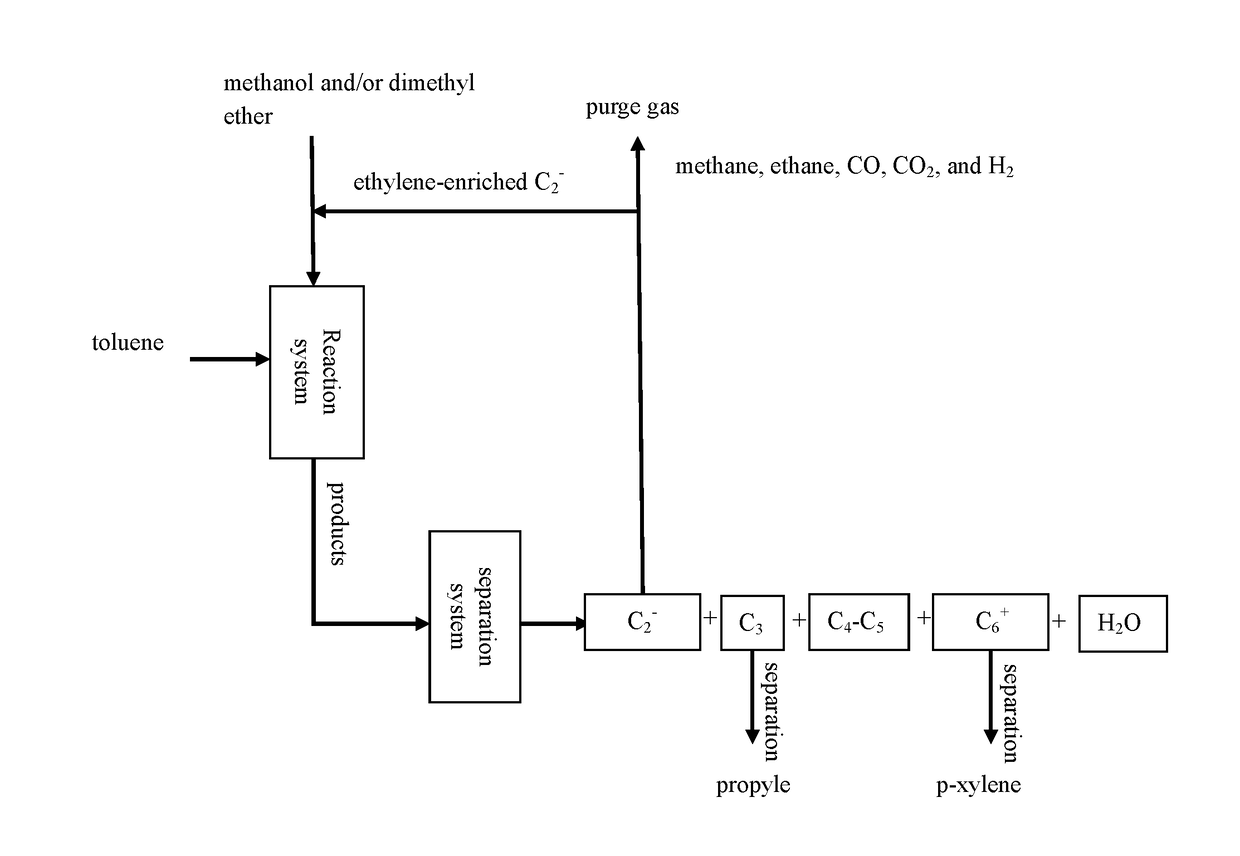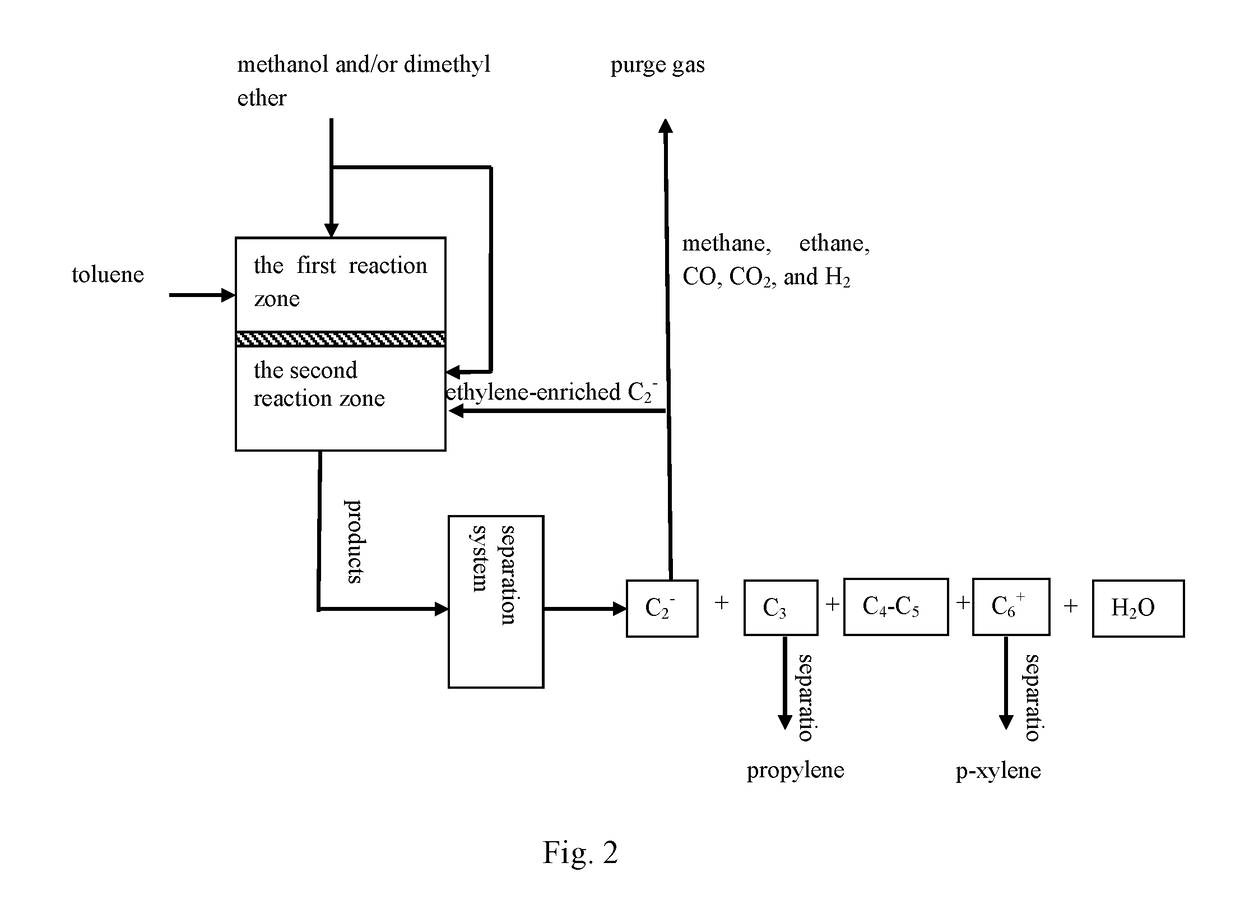Method for preparing p-xylene and co-producing propylene with high selectivity
a technology of pxylene and propylene, which is applied in the direction of catalyst regeneration/reactivation, physical/chemical process catalysts, bulk chemical production, etc., can solve the problems of high operational cost during the whole px production process, high equipment bulk, and high selectivity, so as to avoid the high cost of separation of ethylene products and high selectivity
- Summary
- Abstract
- Description
- Claims
- Application Information
AI Technical Summary
Benefits of technology
Problems solved by technology
Method used
Image
Examples
example 1
[0066]Preparation of Catalysts: Si-HZSM-5 Zeolite Molecular Sieve Catalyst and Si-HZSM-11 Zeolite Molecular Sieve Catalyst
[0067]500 g of ZSM-5 zeolite molecular sieve raw powder (SiO2 / Al2O3=68) (Catalyst Plant of Fushun Petrochemical Company) and 500 g of ZSM-11 zeolite molecular sieve raw powder (SiO2 / Al2O3=50) (Catalyst Plant of Nankai University) were calcined respectively at 550° C. to remove template agents, exchanged with 0.5 molar equivalents of an ammonium nitrate solution in a water bath at 80° C. for 4 times, dried at 120° C. in the air after exchange, and calcined at 550° C. for 4 hours so as to obtain a HZSM-5 zeolite molecular sieve and a HZSM-11 zeolite molecular sieve respectively.
[0068]The HZSM-5 zeolite molecular sieve and the HZSM-11 zeolite molecular sieve were modified by hydrothermal treatment respectively as follows: 100 g of each of the HZSM-5 zeolite molecular sieve and the HZSM-11 zeolite molecular sieve was placed in a quartz reactor respectively, water was...
example 2
[0069]Preparation of catalysts: a mixed catalyst of Si-HZSM-5 and Si-HZSM-11 zeolite molecular sieves 200 g of ZSM-5 zeolite molecular sieve raw powder (SiO2 / Al2O3=61) (Fushun Catalyst Plant) and 300 g of ZSM-11 zeolite molecular sieve raw powder (SiO2 / Al2O3=50) were calcined at 550° C. to remove template agents, exchanged with 0.5 molar equivalents of an ammonium nitrate solution in a water bath at 80° C. for 4 times, dried at 120° C. in the air after exchange, and calcined at 550° C. for 4 hours so as to obtain a HZSM-5 / HZSM-11 zeolite molecular sieve.
[0070]The HZSM-5 / HZSM-11 zeolite molecular sieve was modified by hydrothermal treatment as follows: 100 g of the HZSM-5 / HZSM-11 molecular sieve was placed in a quartz reactor, water was introduced at a flow rate of 5 ml / min after the temperature was increased to 650° C., and a homothermal treatment was performed for 4 hours to obtain a hydrothermally modified HZSM-5 / HZSM-11 zeolite molecular sieve.
[0071]Surface modification was perfo...
example 3
[0072]Preparation of p-Xylene and Co-Production of Propylene Via Reaction of Toluene with Methanol
[0073]According to the reaction process flow shown in FIG. 2, catalyst samples of catalysts TMPC-06, TMPC-07, and TMPC-08 prepared in Examples 1 and 2 were subjected to tablet compression molding and 40-60 mesh target catalysts were obtained by cracking and sieving, each of the catalysts was charged to each of two reaction zones of a fixed bed reactor (10 g for each reaction zone). Conversion reaction of toluene and methanol was carried out in a first reaction zone, wherein the molar ratios of toluene / methanol can be seen in Table 1 below. Alkylation reaction of ethylene and methanol was carried out in a second reaction zone. When a reaction with a certain ratio therein was finished, nitrogen gas was introduced online for purging and then switched to air to regenerate the catalysts under a condition of 550° C. for 5 hours, where an ethylene-enriched C2− component and methanol in the rea...
PUM
| Property | Measurement | Unit |
|---|---|---|
| temperature | aaaaa | aaaaa |
| temperature | aaaaa | aaaaa |
| temperature | aaaaa | aaaaa |
Abstract
Description
Claims
Application Information
 Login to View More
Login to View More - R&D
- Intellectual Property
- Life Sciences
- Materials
- Tech Scout
- Unparalleled Data Quality
- Higher Quality Content
- 60% Fewer Hallucinations
Browse by: Latest US Patents, China's latest patents, Technical Efficacy Thesaurus, Application Domain, Technology Topic, Popular Technical Reports.
© 2025 PatSnap. All rights reserved.Legal|Privacy policy|Modern Slavery Act Transparency Statement|Sitemap|About US| Contact US: help@patsnap.com



